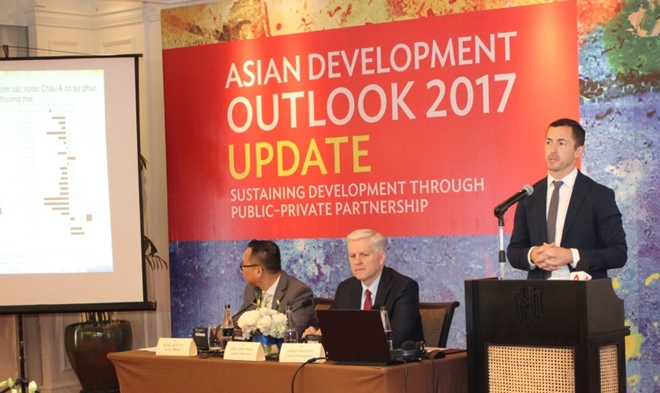Vietnam economy resilient against unexpected shocks
As a result of an 8% contraction in mining and oil output in the first half of the year, the Asian Development Outlook Update (ADOU) 2017 forecasts a downward revision in Viet Nam’s economic growth to 6.3% in 2017, and 6.5% in 2018.
“Despite the drop in mining and oil output, Viet Nam’s economy continues to perform well, driven by its twin engines of export-orientated manufacturing and rising domestic consumption”, said Mr. Eric Sidgwick, ADB Country Director for Viet Nam. ”Manufacturing expanded by 10.5% in the first half of the year as new foreign-invested factories ramped up production, while the services sector continued to pick up steam as a result of rising retail trade, growing bank lending and a 30% jump in tourism arrivals.”
 |
Viet Nam’s economic growth is expected to rise in the second half of the year, buoyed by further increases in foreign direct investment and exports, domestic credit growth, a further recovery in agriculture from the 2016 drought and accelerating disbursements of capital expenditure on national infrastructure programs.
The report stressed that while Viet Nam’s economy is performing reasonably well against a challenging back-drop, several issues will need to be addressed to ensure growth remains sustainable.
Recent efforts to raise already strong bank lending growth by lowering interest rates to historical lows have the potential to increase financial sector risks, particularly given the large stock of past unresolved bad debts.
To ensure these risks are well managed it will be vital to strengthen regulations and supervision on loan quality and to continue the introduction of more stringent, Basel II, regulatory standards over the next 12-18 months.
Further, while recent progress in trimming the budget deficit is commendable, it has also led to a drop in capital spending which if not rebalanced could erode Viet Nam’s long-term growth performance.
For Viet Nam’s fiscal consolidation to be ‘growth-friendly’ the authorities may usefully focus on adopting additional taxation measures while trimming non-core public expenditures such as administrative expenses which have crowded-out infrastructure in recent years.
The report noted that while export-oriented manufacturing remains a bright spot for Viet Nam’s economy, the trade surplus narrowed faster than expected, as surging imports outpaced export growth. In the first 6 months of the year, the trade surplus shrank to equal an estimated 1.5% of GDP from 8.1% in the first half of 2016.

